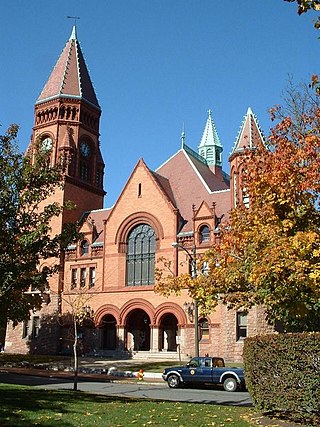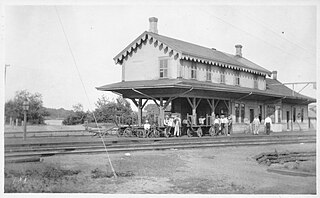
Fairhaven is a town in Bristol County, Massachusetts, United States. It is located on the South Coast of Massachusetts where the Acushnet River flows into Buzzards Bay, an arm of the Atlantic Ocean. The town shares a harbor with the city of New Bedford, a place well known for its whaling and fishing heritage; consequently, Fairhaven's history, economy, and culture are closely aligned with those of its larger neighbor. The population of Fairhaven was 15,924 at the time of the 2020 census.

Marion is a town in Plymouth County, Massachusetts, United States. The population was 5,347 at the 2020 census.

Rochester is a town in Plymouth County, Massachusetts, United States. The population was 5,717 at the 2020 census.

Wareham is a town in Plymouth County, Massachusetts, United States. As of the 2020 census, the town had a population of 23,303.

The Old Colony Railroad (OC) was a major railroad system, mainly covering southeastern Massachusetts and parts of Rhode Island, which operated from 1845 to 1893. Old Colony trains ran from Boston to points such as Plymouth, Fall River, New Bedford, Newport, Providence, Fitchburg, Lowell and Cape Cod. For many years the Old Colony Railroad Company also operated steamboat and ferry lines, including those of the Fall River Line with express train service from Boston to its wharf in Fall River where passengers boarded luxury liners to New York City. The company also briefly operated a railroad line on Martha's Vineyard, as well as the freight-only Union Freight Railroad in Boston. The OC was named after the "Old Colony", the nickname for the Plymouth Colony.

The Cape Cod Railroad is a railroad in southeastern Massachusetts, running from Pilgrim Junction in Middleborough across the Cape Cod Canal Railroad Bridge, where it splits towards Hyannis in one direction and Falmouth in the other. It was incorporated in 1846 as the Cape Cod Branch Railroad to provide a rail link from the Fall River Railroad line in Middleborough to Cape Cod.

The South Coast of Massachusetts is the region of southeastern Massachusetts consisting of the southern Bristol and Plymouth counties, bordering Buzzards Bay, and includes the cities of Fall River, New Bedford, the southeastern tip of East Taunton and nearby towns. The term is recent, dating to the 1990s, and sometimes confused with the South Shore.

The Bay Colony Railroad is a shortline railroad operating in Massachusetts.

The Old Colony Lines are a pair of branches of the MBTA Commuter Rail system, connecting downtown Boston, Massachusetts with the South Shore and cranberry-farming country to the south and southeast. The two branches operate concurrently for 10 miles (16 km) via the Old Colony Mainline from South Station to Braintree station. The Middleborough/Lakeville Line then winds south through Holbrook, Brockton, Bridgewater, Middleborough, and Lakeville via the Middleborough Main Line and Cape Main Line. The Kingston Line heads southeast to serve Weymouth, Abington, Whitman, Hanson, Halifax, and Kingston by way of the Plymouth branch. Limited service to Plymouth was provided prior to April 2021 but was cut due to low ridership and budget constraints.

The Cape Cod Rail Trail (CCRT) is a 25.5-mile (41.0 km) paved rail trail located on Cape Cod in Massachusetts. The trail route passes through the towns of Yarmouth, Dennis, Harwich, Brewster, Orleans, Eastham, and Wellfleet. It connects to the 6-plus mile (10 km) Old Colony Rail Trail leading to Chatham, the 2 mile Yarmouth multi-use trail, and 8 miles (13 km) of trails within Nickerson State Park. Short side trips on roads lead to national seashore beaches including Coast Guard Beach at the end of the Nauset Bike Trail in Cape Cod National Seashore. The trail is part of the Claire Saltonstall Bikeway.

The Hyannis Transportation Center (HTC) is an intermodal transportation center in Hyannis, Massachusetts, operated by the Cape Cod Regional Transit Authority (CCRTA). It is the terminus for several CCRTA bus lines and its CapeFLYER passenger train that operates on summer weekends between Boston South Station and Hyannis. It is also used by the Plymouth and Brockton Street Railway, Peter Pan Bus Lines, and Greyhound via CapeBus intercity bus services. The Cape Cod Central Railroad uses a separate station building across the tracks for its excursion services. A rail yard used by the Cape Cod Central is located north of the station, along with a former roundhouse.

Falmouth station is a bus station and former railroad station in Falmouth, Massachusetts. Built in 1912 to replace an older station, it was used for rail service until 1964, with brief revivals in 1984 and 1988.

The Boston, Clinton, Fitchburg and New Bedford Railroad was a railroad in Massachusetts. It was formed on June 1, 1876, when the Boston, Clinton and Fitchburg Railroad merged with the New Bedford Railroad. The Boston, Clinton and Fitchburg Railroad connected with the key railroad hubs of Worcester, Framingham, and Ayer, as well as several important industrial towns such as Fitchburg and Lowell, with the latter coming through a lease of the Framingham and Lowell Railroad. The New Bedford Railroad linked Framingham with New Bedford, which was a key deep-water port.
First Citizens' Federal Credit Union is a federally chartered credit union headquartered in Fairhaven, Massachusetts in the AT&T Building on Mill Road.

The CapeFlyer is a passenger rail service in Massachusetts between Boston and Cape Cod that began in 2013. It is operated by the Cape Cod Regional Transit Authority (CCRTA) in collaboration with the Massachusetts Bay Transportation Authority (MBTA) and the Massachusetts Department of Transportation (MassDOT). The service runs on the weekends, beginning Friday evenings and including holidays, between Memorial Day weekend and Labor Day weekend.

Wareham Village station is a train station that is located on Merchants Way in Wareham, Massachusetts. Service to Wareham formerly ran from 1848 until 1959. A shelter, built in 1985 for short-lived Amtrak and commuter service, is currently unused. A new platform constructed nearby for the CapeFLYER summer weekend service opened for the CapeFLYER on June 27, 2014.

Bournedale station was a railroad station serving Bournedale, Massachusetts. Opened in 1848, it was relocated in 1911 during construction of the Cape Cod Canal and closed in the 1920s.

Onset station is a former train station located on Depot Street in the village of East Wareham, Massachusetts. Originally known as Agawam, then East Wareham, it was combined with a nearby station under the name Onset Junction in 1891. Known as Onset by the 1930s, it was closed in 1959. The station building remains in use by a business.

Tremont station was located on Mill Street in West Wareham, Massachusetts. The station was located just east of the former junction of the Cape Cod Branch Railroad and the Fairhaven Branch Railroad.





















